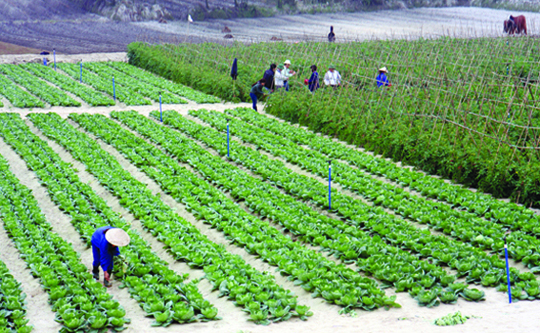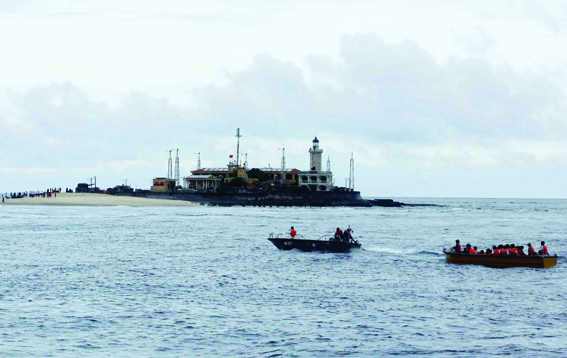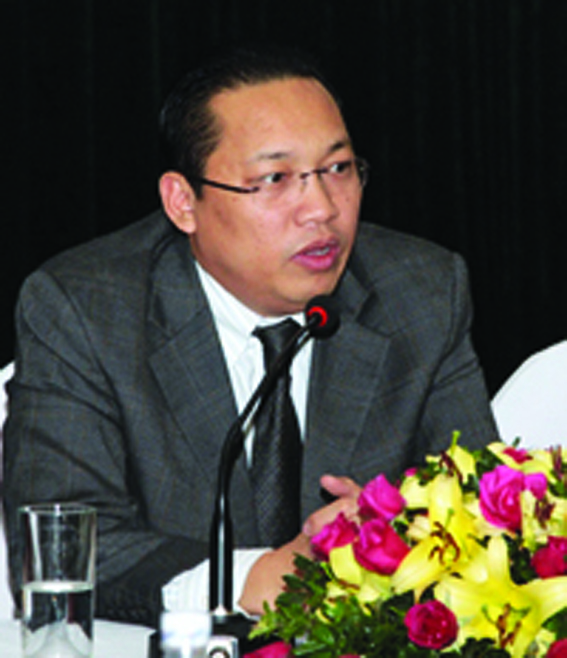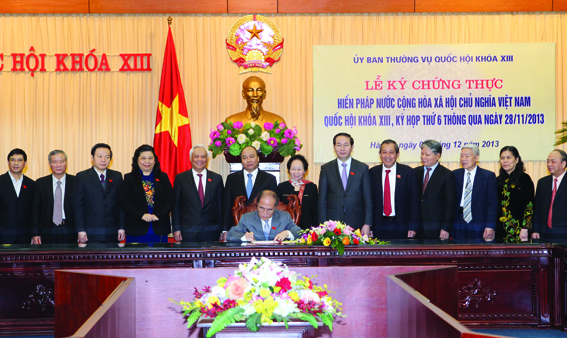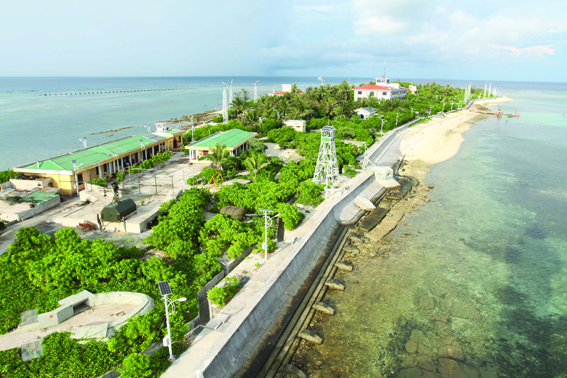Nguyen Van Giau
Member of the Standing Committee,
Head of the Economic Committee of the National Assembly
The revised Constitution of Vietnam was passed on November 28, 2013, by the XIIIth National Assembly at its sixth session.

Terraced fields in Sa Pa, Lao Cai province__Photo: Nguyen Thuy/VNA
The constitutional provisions on land have been revised to be more coherent, demonstrating the viewpoint that land is under the ownership of the entire people and is uniformly managed by the State as the representative of the owner. The revised Constitution reaffirms in Article 54:
“1. Land is a special national resource and an important resource for national development and is managed in accordance with law.
2. The State shall allocate or lease land to, and recognize the land use rights of, organizations and individuals. Land users may transfer land use rights, exercise their rights and perform their obligations in accordance with law. Land use rights shall be protected by law.
3. The State may recover land currently used by organizations or individuals in case of extreme necessity prescribed by law for national defense or security purposes; or socio-economic development in the national or public interest. Land recovery must be public and transparent, and compensation must be paid in accordance with law.
4. The State may requisition land in cases of extreme necessity prescribed by law to perform national defense and security tasks or during a state of war or a state of emergency, or in response to a natural disaster.”
So, in the light of such constitutional provisions on land, the new Land Law, comprising 14 chapters with 212 articles, spells out specific provisions on important issues.
Land ownership
The new Land Law defines the rights of the State in the capacity as representative of the land owner being the entire people, which shall perform the unified management of land.
These rights include: to decide on land use master plans and plans; to prescribe the quotas of agricultural land and residential land allocation, quotas of recognition of residential land use rights and acquisition of agricultural land use rights; to define the land use term; assign land use rights to land users in form of land allocation, land lease or recognition of land use rights; to decide on recovery of land for defense or security purposes, or for socio-economic development in the national or public interest; to decide to requisition land in case of extreme necessity to perform national defense and security tasks or during a state of war or a state of emergency or in response to a natural disaster; to define the land price-fixing principles and methods, promulgate land price frames and tables and decide on specific land prices; to decide on land-related financial revenue and expenditure policies; to regulate the added value coming from land not from investment by land users through policies on taxes, land use levy, land rental, infrastructure investment, and support for persons having their land recovered.
In exercising the right to represent the land owner, the National Assembly shall promulgate laws and resolutions on land and decide on national land use master plans and plans. The People’s Councils at different levels shall adopt local land use master plans and plans before submitting them to competent authorities for approval; approve land price tables, and the recovery of land for local socio-economic development projects; and supervise the enforcement of land law in localities.
The 2013 Land Law prescribes that the State shall protect the lawful land use rights and land-attached assets of land users; grant certificates of the rights to use land and the rights to own houses and other land-attached assets to land users; adopt policies to create conditions for agricultural, forestry, aquaculture and salt producers, who are reduced to no more land for production due to the land use restructuring and economic restructuring, to be vocationally trained and shift to other occupations and seek employment. When the State recovers land for defense and security purposes or socio-economic development in the national or public interest, land users will be compensated, supported and resettled by the State in accordance with law. The State shall not recognize the reclaim of land allocated by the State in accordance with law to other persons for use in the process of implementation of land policies of the Democratic Republic of Vietnam State, the Provisional Revolutionary Government of South Vietnam Republic or the Socialist Republic of Vietnam State. The State shall adopt policies on residential land, community activity land for ethnic minority people in conformity with the customs, practices, cultural identity and practical conditions of each region; and adopt policies to create conditions for ethnic minority people directly engaged in agricultural production in rural areas to have land for agricultural production. In addition, the State is liable to provide information on land and guarantee the access of organizations and individuals to land information.
Land use rights
The 2013 Land Law institutionalizes the constitutional provisions on land use rights (LURs), saying: “Land users may transfer the land use rights, exercise their rights and perform their obligations in accordance with law. Land use rights shall be protected by law.”
It devotes Chapter XI to the definition of rights and obligations of land users, specifying the rights and obligations of each type of land user corresponding to the form of land allocation, land lease and land use rights recognition, and prescribing conditions for land users to exercise their rights. Land users have such common rights as: To be granted certificates of the rights to use land, the rights to own houses and other land-attached assets; to enjoy the fruits of their labor and investment on land; to enjoy the benefits of state-financed works for agricultural land protection and improvement; to be provided by the State with guidance and assistance in transformation and improvement of agricultural land; to be protected by the State when their lawful rights and interests related to land are infringed upon by other persons; to be compensated when the State recovers land; to lodge their complaints, denunciations or lawsuits against infringements upon their lawful LURs and other violations of the land law.
Land users may exercise their rights to exchange, transfer, lease, sublease, inherit, donate, mortgage, contribute as capital their LURs, depending on each type of land and land use origin.
The Land Law also defines such obligations of land users as: To use land for proper purposes, within the boundaries of land parcels, in accordance with regulations on the use of underground depth and height from the ground, the protection of underground public works and the observance of relevant laws; to make land declaration and registration; to complete all procedures upon exchange, transfer, lease, sublease, inheritance or donation of LURs; to mortgage or contribute as capital LURs in accordance with law; to fulfill financial obligations as prescribed by law; to apply measures for protection of land; to comply with regulations on environmental protection, without harming the lawful interests of related land users; to comply with legal provisions on discovery of objects underground; to return land under state decisions on land recovery or at the expiry of the land use term which is not extended by a competent state agency.

Resettlement condominiums in Dich Vong, Cau Giay district, Hanoi__Photo: Tuan Anh/VNA
Land recovery
Detailing the constitutional provisions that “the State may recover land currently used by organizations or individuals in case of extreme necessity prescribed by a law for national defense or security purposes or socio-economic development in the national or public interests”, the new Land Law prescribes specific cases of land recovery for national defense or security purposes such as: construction of military stations, working offices, military bases, national defense works, battle fields and special defense or security facilities; construction of military railways stations and ports; construction of industrial, scientific and technological, cultural or sport facilities in direct service of national defense or security; construction of storehouses of the people’s armed forces; construction of shooting ranges, drill grounds, weapon-testing grounds, weapon- destroying grounds; construction of training establishments or centers, hospitals, convalescence homes of the people’s armed forces; construction of public-duty houses of the people’s armed forces; construction of detention or education camps managed by the Ministry of National Defense or the Ministry of Public Security.
It also clearly specifies cases of land recovery for socio-economic development in the national or public interest, including:
(1) Execution of important national projects decided by the National Assembly, which require land recovery;
(2) Execution of projects approved and decided by the Prime Minister, which require land recovery, including projects on construction of industrial parks, export processing zones, hi-tech parks, economic zones, new urban centers; investment projects financed by official development assistance (ODA) sources; projects on construction of working offices of central-level state agencies, political organizations, socio-political organizations; working offices of foreign organizations with diplomatic functions; classified historical and cultural relics and scenic places, parks, public squares. Monuments, memorial stela, national public non-business facilities; projects on construction of national technical infrastructures, covering transport, irrigation, water supply, water drainage, electricity, communications; petrol and gas conducting and storage systems; national reserve storehouses; waste collection and treatment facilities;
(3) Execution of projects approved by provincial-level People’s Councils, which require land recovery, including projects on construction of working offices of local state bodies, political organizations, socio-political organizations; ranked cultural and historical relics as well as scenic places, parks, public squares, monuments, memorial stela, public non-business facilities; projects on construction of local technical infrastructure, covering transport, irrigation, water supply, water drainage, electricity, communications, urban lighting, waste collection and treatment facilities; projects on construction of facilities to serve public activities of communities; projects on resettlement, dormitories for students, social houses, public-duty houses; construction of religious establishments, public cultural, sport and entertainment and recreation centers, marketplaces, cemeteries, graveyards, funeral service houses, crematories; projects on construction of new urban centers, new rural residential quarters; embellishment of urban and rural areas; industrial clusters; concentrated agricultural, forestry and fishery production and processing zones; projects on development of protection and special-use forests; licensed mining projects, excluding the exploitation of minerals for use as ordinary building materials, peat, minerals in small and scattered mineral areas and the salvage mining of minerals.
For production and business projects and works, which do not fall within the cases of land recovery by the State but conform with the land use master plans and plans, investors may acquire or lease LURs or receive LURs as capital contribution in accordance with law. The State shall adopt policies to encourage the lease of LURs and the receipt of LURs as capital contribution of economic organizations, households or individuals for execution of production and business projects and works.
Projects requiring land recovery must be included in annual district-level land use plans, which serve as a basis for provincial- or district- level People’s Committees to issue decisions on land recovery.
The Land Law specifies cases of land recovery for socio-economic development in the national or public interest, aiming to curb abuse of power in the recovery of land. These cases of land recovery have been taken into careful consideration according to the criterion of “being in national or public interest” in conformity with the new Constitution.
Besides, the Land Law also prescribes cases of land recovery due to violations of law, the default of heirs, the voluntary return of land by land users, the existence of a danger threatening the life of people. The land recovery in these cases is only the administrative measure applied by the State to revoke the LURs, which does not infringe upon the LURs protected by law.
Agricultural land
The agricultural land use term prescribed by the Land Law for households and individuals is 50 years. The extension of the agricultural land use term to 50 years for households and individuals growing annual crops, conducting aquaculture or producing salt aims to redress the current inequality between farmers and enterprises which are currently leased land for agricultural production and business for 50 years. Meanwhile, a single land use term will be applicable to all types of agricultural land.
Meanwhile, the agricultural land allocation quota prescribed by the 2003 Land Law for households and individuals directly engaged in agricultural, forestry, aquaculture or salt production is retained, aiming to stabilize the legal system and the life of these people.
However, the quota for receipt of transferred agricultural land use rights increases to not more than ten times the agricultural land allocation quota of a household or an individual for each type of land. This provision aims to ensure production land for farmers as well as the conformity of the process of land accumulation, concentration and transfer with the economic restructuring as well as agricultural labor restructuring; to ensure the employment of local agricultural labor in rural areas, facilitating the process of agricultural land accumulation and concentration into large-scale production zones, and meeting the requirements of agricultural commodity production.
Compensation, support and resettlement
To detail the constitutional provisions that “land recovery must be public and transparent, and compensation must be paid in accordance with law”, the new Land Law specifies the compensation, support and resettlement applicable to persons having their land recovered. It provides that persons with land recovered will be compensated for land, land-attached assets, and costs of investment in land. The land prices for calculation of compensation to land users will be the specific land prices decided by provincial-level People’s Committees at the time of deciding to recover land, with the participation of consultancy organizations in determining the land prices.
The Land Law also specifies the conditions for compensation for land, for investment in remaining investment costs, compensation for land-attached assets, applicable to each type of land and each specific type of land user, compensation for costs of dismantlement, transportation and installation of assets, compensation for damage caused by production and business cessation.
It prescribes different financial amounts in support of persons with land recovered, including support for stabilization of their livelihood and production; support for vocational training, occupation shift and job seeking; support for resettlement applicable to the case of relocation due to the recovery of residential land, and so on. Provincial-level People’s Committees shall organize the formulation and implementation of plans on support for vocational training, occupation shift and job seeking, applicable to persons with recovered land being agricultural land or residential-cum-service business land, which will be approved simultaneously with the compensation, support and resettlement plans.
Under the new Land Law, persons having their land recovered will be resettled. Organizations performing compensation and ground clearance tasks shall draw up plans for compensation, support and resettlement and coordinate with commune-level People’s Committees of localities where the land is recovered in collecting opinions on the compensation, support and resettlement plans and organizing dialogues with persons who disagree with such plans. Concentrated resettlement zones must be built with complete infrastructure and conform with the conditions, customs and practices of each region. Residential land can be recovered only after the construction of houses and infrastructure resettlement zones is completed.
The Land Law also provides the handling of cases of delayed payment of compensation due to the fault of state bodies or persons with their land recovered in order to heighten the responsibility of state bodies in performing their duties as well as the sense of law observance of the people.
Requisition of land
The new Constitution provides two different cases of property requisition and land requisition in Clause 3 of Article 32 and Clause 4 of Article 54. Accordingly, the State shall requisition land in case of extreme necessity prescribed by law for the performance of national defense or security tasks or in case of a state of war or a state of emergency to prevent and combat a natural disaster. So, as land is a special national resource not owned by any organizations or individuals, the general procedures for requisition of property cannot be applied.
Detailing such constitutional provisions, the Land Law defines the land requisition in cases of extreme necessity for the performance of national defense or security tasks or in a state of war, or a state of emergency to prevent and combat a natural disaster. It specifies the order, procedures and competence for land requisition, the duration of land requisition and the compensation for damage caused by land requisition.
Land price
Under the constitutional provision that the State is assigned to act as a representative of the land owner being the entire people, the Land Law stipulates that the State shall decide on land prices through the prescription of land price frames and tables, and decide on specific land prices.
The setting of land price must comply with the lawful land use purpose at the time of price setting and with the land use term, and conform with the common market land prices of the transferred land of the same type and use purpose or with the incomes earned from land use or the winning bids in areas where land use rights are put up for auction. Adjacent land parcels having the same use purpose and yielding similar benefits or incomes at a time must have the same price. The land price frames and tables must be established once every five years and adjusted upon market fluctuations. In case different localities cannot reach agreement on the prices of land in the bordering areas of provinces or centrally run cities, this issue must be reported to the Prime Minister for decision.
The land price tables will be used in the following cases:
(1) Calculation of land use levy when the State recognizes residential land use rights of households or individuals for the land area within the quota; permits the use purpose change from agricultural or non-agricultural land to residential land within the residential land quota assigned to households or individuals;
(2) Calculation of land use tax;
(3) Calculation of charges and fees for land management and use;
(4) Calculation of fines on administrative violations related to land;
(5) Calculation of compensation paid to the State when damage is caused in the land management and use;
(6) Calculation of land use right value for payment to those who voluntarily return land to the State, if the returned land is the land allocated by the State with land use levy or leased with full one-off rental payment for the entire lease term.
Specific land prices will be decided by provincial-level People’s Committees at the time of price setting, with the participation of land price consultancy organizations. They will apply to the following cases:
(1) Calculation of land use levy when the State recognizes LURs of households or individuals for land areas in excess of the prescribed quota; or the State permits the use purpose change from agricultural or non-agricultural land to residential land, for land areas in excess of the prescribed residential land quota assigned to households or individuals; calculation of land rental for agricultural land areas in excess of the quotas of agricultural land allocation or recognition of agricultural land use rights of households or individuals;
(2) Calculation of land use levy when the State allocates land with land use levy without LURs auction; recognizes LURs or permits the use purpose change for organizations with land use levy payment;
(3) Calculation of land rental if the State leases land without LURs auction;
(4) Calculation of land use right value upon equitization of state enterprises if the equitized enterprises use land which is allocated by the State with land use levy or leased by the State with full one-off rental payment for the entire lease term.-
